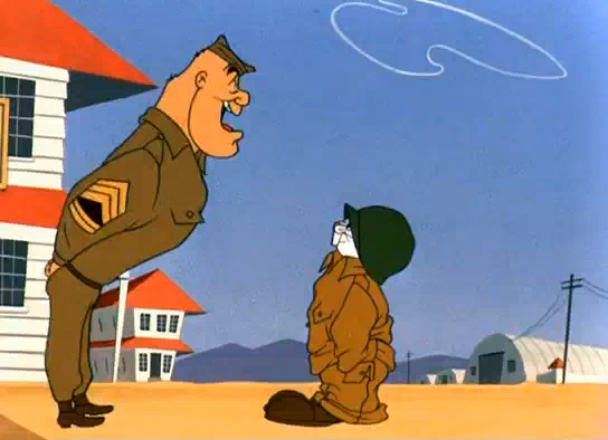I read this New Yorker article (by Adam Gopnik) reviewing a biography of Bob Hope yesterday on a plane. It’s a pretty good article, but one section kinda stood out — and half-entertained, half-confused me. Namely, there’s this idea that maybe Bugs Bunny helps explain the U.S. Army as a concept. Yep.
Here’s the paragraph from the Gopnik article:
The real parallel to Hope—the great American comedian whose career most closely resembles his—is, of course, Bugs Bunny. Like Hope, he arrived in Hollywood in the late thirties and became a huge star with the war. Like Hope, he was usually paired with a more inward character who loves to sing (Daffy Duck is Bugs’s Bing, though blustery rather than cool), and, like Hope, his appeal rises entirely from the limitless brashness and self-confidence with which he approaches even the most threatening circumstances. Together, they are the highest expression of the smart-aleck sensibility in American laughter. Their fame in wartime may have something to do with the way that, as A. J. Liebling documents, the American Army itself was essentially an urban creature dispatched to deserts and jungles: Bugs, with his Bronx-Brooklyn accent, has somehow been sent out there in the countryside, among the hunters, as Hope ends up in the sands of Morocco with no weapon but street-corner sass.
The U.S. Army was an urban creature forced to fight in deserts and jungles.
Bugs Bunny is a cartoon bunny with New York sass that ends up in the far reaches himself.
Bugs and Daffy did make a lot of wartime cartoons, and there’s even belief some of them might have been racist.
Here’s one:
Here’s some banned ones:
Here’s a remastered version of Falling Hare, one of the better Bugs Bunny wartime ones:
And here’s essentially straight propaganda related to buying war bonds:
There’s also Herr Meets Hare:
According to Wikipedia, Bugs’ popularity soared during WW2 because of his “free and easy attitude.” Cool. He’s also apparently one of two animated characters with a Hollywood Walk of Fame star, and by some measure he’s the ninth-most depicted character in film history.
Does he necessarily explain the modern rise of the U.S. Army? No. Is he somewhat of an analogy for that rise and how it took place, with a lot of fish-out-of-water context in foreign lands but a generally affable, can-do spirit? Sure, to an extent. Now, Bugs with PTSD would be a total mess of a cartoon, though. (Didn’t mean that last line to be glib. I tremendously respect everything the U.S. Army has done — but I also do realize it’s a concern that often happens with soldiers.)
